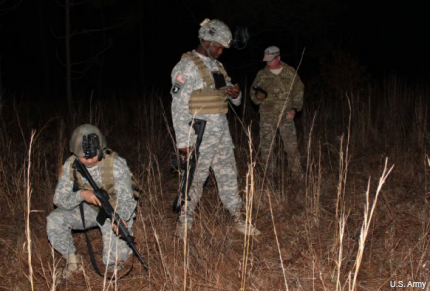Feel the force: Army tests tactile comm for the battlefield
The Army Research Lab’s haptic system helps soldiers navigate, communicate and identify targets at night without having to look at a screen.

Soldiers train on the system before taking the field.
Mobile devices with tactical mapping apps can greatly improve situational awareness on the battlefield. But they have a downside: When you’re looking at the screen, you’re not looking at what’s around you.
A team at the Army Research Laboratory is working on ways to help soldiers keep their eyes front, testing haptic technology that would use vibrations or other tactile signals to direct soldiers according to map coordinates.
Researchers have tested a miniature, networked haptic system with GPS capability in a belt, for instance, that directed soldiers through a course by delivering vibrations or pulses, according to an Army report. In its simplest form, a signal in the front of the belt told a soldier to more forward, in the back to move backward. Or a soldier could turn until the signal was felt in the front.
The system also allows for signals from soldier-to-soldier or even from some ground robots, working with a tactile vocabulary—comparable to Morse Code or the different ring options on a cell phone—that could deliver status updates, warnings or whether to perform a certain task. Soldiers still have a map display with them, but they can keep it in their pocket, while keeping their hands on a weapon and their eyes on what’s in front of them.
In tests, soldiers using the system completed combat courses more quickly and said they had better situational awareness, the Army said.
"Data are still being compiled, however, it is clear that soldiers rarely looked at the visual display when the tactile belt was 'on.' Soldier feedback was very positive," said Gina Hartnett of ARL’s Human Research and Engineering Directorate's field element at Fort Rucker, Ala. "This assessment gave us a great example of how a device can free up the senses so effectively.”
Part of the system’s appeal is its simplicity—soldiers were able to learn the system in 10 or 15 minutes, the Army said. And although they tested the system in a belt, the tactile actuators that deliver the signals could just as well be placed in a glove, helmet or vest.
The tests included night combat exercises at Fort Benning, Ga., on two courses about 900 meters long, testing navigation and robot communication and monitoring using two types of tactile systems. Soldiers navigated from waypoint to waypoint, received signals from a hypothetical autonomous robot about status or threats, and identified enemy targets along the way.
Researchers collected data on the accuracy of the navigation signals and robot alerts, how often soldiers looked at their map screens or took their hands off their weapons, and whether they correctly identified targets. Afterward, researchers also collected feedback from soldiers.
"It's not often a soldier can pick up a piece of equipment, be trained in five to 10 minutes, and have a very positive experience,” said Dr. Linda Elliott, from HRED's Fort Benning field element. “In a previous night study, soldiers said they were blind (night, fog, rain, night vision devices fogging up, etc.) and the belt led them straight to point, allowing them to focus attention on their surroundings."
Researchers are still working on ways to improve the signals, which need patterns that are distinct, easily felt and easily interpreted. The systems also must meet military requirements for weight, ruggedness and networking. But ARL’s recent tests and other research indicate that tactile communications are likely to become more common.




